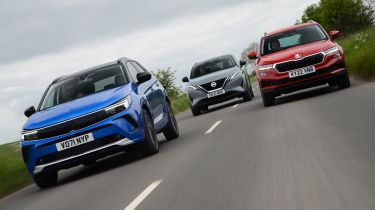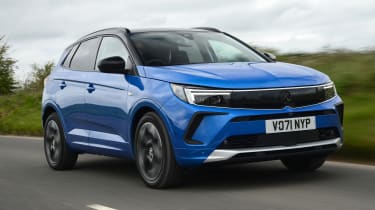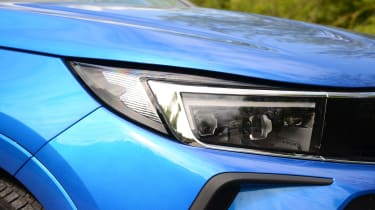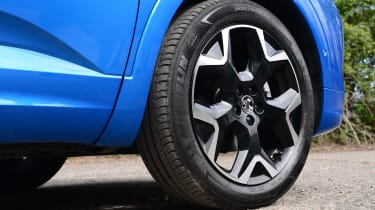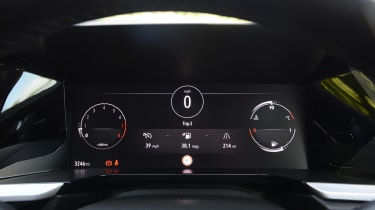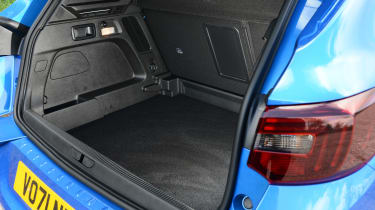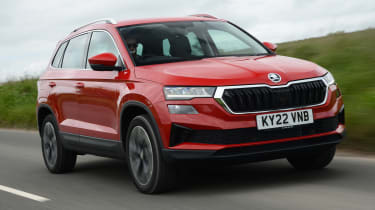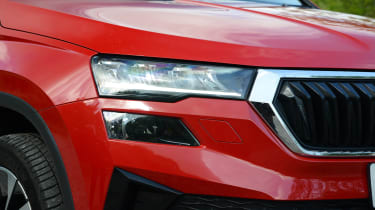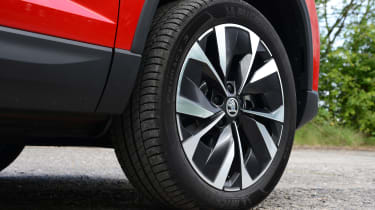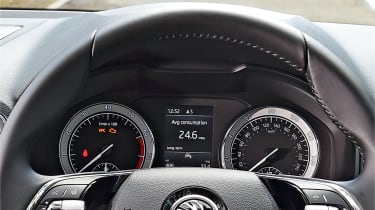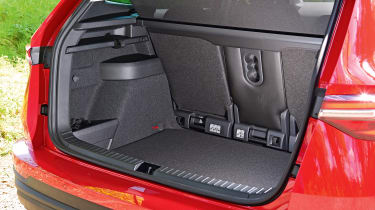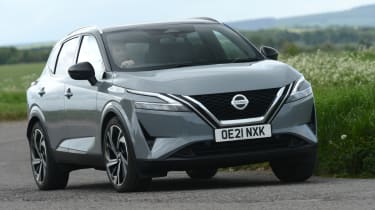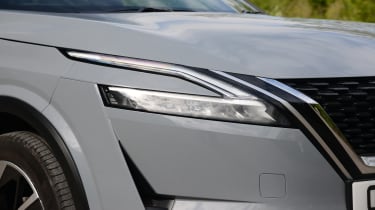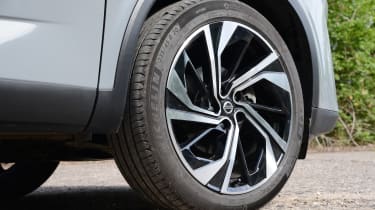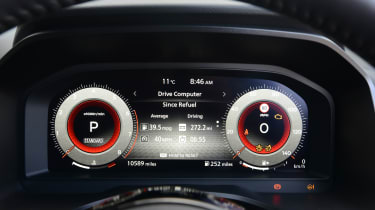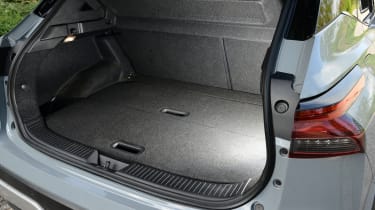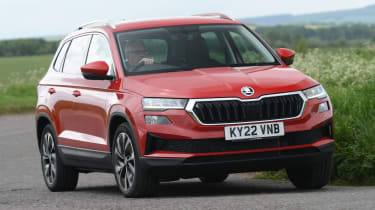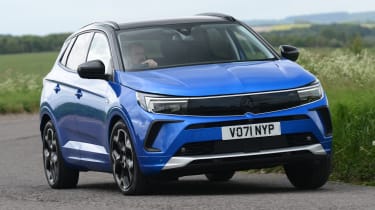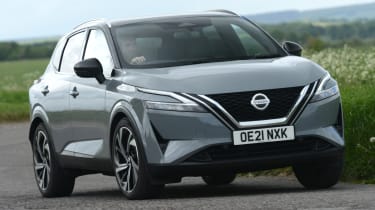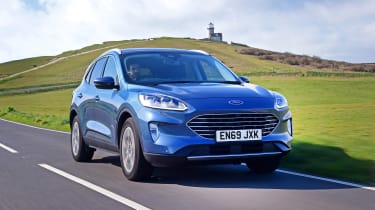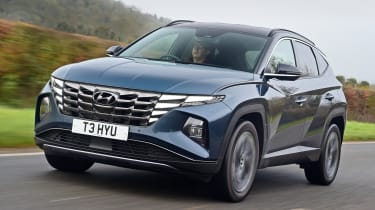Vauxhall Grandland vs Skoda Karoq vs Nissan Qashqai: 2022 group test review
Vauxhall’s family SUV has received a makeover – how does it compare with its Skoda and Nissan rivals?
Buyers looking for a family SUV are spoiled for choice, because pretty much every mainstream car maker offers one. Some of the top models have been around for a while, though, so the time has come for a few to get a mid-life refresh.
The latest is the Vauxhall Grandland. It gets a pretty significant update, with a new face, new tech and the loss of an X from its name. It has some tough competition in the form of the Skoda Karoq, though, which has also been updated. This is a model that has consistently been a class leader, so Skoda hasn’t messed with the formula too much.
We also have the Nissan Qashqai. Technically the Mk3 is the oldest model in this test, but the Vauxhall and Skoda have been on sale in pre-facelift form for longer.
Family SUVs need to combine practicality, comfort, technology and efficiency, so we’ll be looking at those areas closely on these three petrol models to reach our verdict.
Vauxhall Grandland
|
Model: |
Vauxhall Grandland 1.2 Turbo Ultimate |
|
Price: |
£32,480 |
|
Engine: |
1.2-litre 3cyl turbo, 128bhp |
|
0-62mph: |
10.4 seconds |
|
Test economy: |
44.8mpg/9.9mpl |
|
CO2: |
141g/km |
|
Annual road tax: |
£165 |
The Vauxhall formerly known as the Grandland X is now simply the Grandland. It’s easy to tell apart from the previous version because of its new front end. The model we’re testing here is the 1.2-litre petrol in top-spec Ultimate trim, which costs £32,480.
Used - available now

2021 Kia
Sportage
31,153 milesManualPetrol1.6L
Cash £16,170
2024 BMW
1 Series
10,413 milesAutomaticPetrol2.0L
Cash £26,900
2021 Ford
Mustang Mach-E
30,486 milesAutomaticElectric
Cash £21,200
2022 Kia
e-Niro
20,469 milesAutomaticElectric
Cash £16,800Design & engineering
At first glance, the Vauxhall Grandland looks totally different from the previous Grandland X, because it now comes with the smooth, black Vizor grille design found on other models such as the Mokka and latest Astra. It helps the new model to stand out where the previous version looked rather plain.
It’s still based on the same EMP2 platform as before, though, which underpins plenty of other models from Vauxhall, Citroen and Peugeot. It means the Grandland is closely related to the Peugeot 3008, although there are some key differences in how each drives.
The Grandland tested here uses a familiar engine, too, the 1.2 PureTech three-cylinder turbocharged motor with 128bhp and 230Nm of torque. There’s a six-speed manual gearbox and the Vauxhall is front-wheel drive, like both of its rivals here. The EMP2 platform allows for the creation of hybrid models too, and there’s a plug-in Grandland available. That’s not the case at all for the Skoda, while the Nissan is available with mild-hybrid assistance.
Unlike the Peugeot 3008, the Grandland has a conventional interior with a normal-sized steering wheel, which makes a positive difference to the driving experience. There’s a new infotainment set-up and it works well enough, although most will prefer using Android Auto or Apple CarPlay, which both come as standard.
Equipment is excellent in this high-spec Ultimate model. It comes with LED lights, a 360-degree parking camera, adaptive cruise control, a 10-inch touchscreen, a digital dash, wireless phone charging, keyless go, a powered tailgate and 19-inch alloys.
It also comes with seats approved by AGR, an organisation that promotes healthy posture. These are potentially good for those with back pain, so they are rather firm and take some getting used to.
Driving
As well as firm seats, the Grandland suffers from a stiff ride. It’s fine for trips on the motorway and on smoother surfaces, but in towns and on worse-kept country roads the Grandland is less comfortable than the Skoda Karoq. Those in the back will feel the bumps even more, because it’s the rear axle that seems to take the brunt of the bumps and potholes.
This is a shame, because the Grandland is actually better to drive than many of its EMP2-based siblings, including the Peugeot 3008. The Vauxhall has light steering that has virtually no feel, but that’s the standard in this class. What matters is that it’s easy to use and doesn’t unsettle the car, because it’s set up to be comfortable rather than responsive.
The Vauxhall’s six-speed manual gearbox is also surprisingly slick, given our experience of other models with this engine and gearbox. It has a better shift action than any other EMP2-based car we’ve tried, although it’s still not as precise as the Skoda’s gearbox.
The 1.2-litre engine is as solid as ever. Figures of 128bhp and 230Nm are the least of the three cars here, but it still feels punchy – performance is certainly adequate for family life. It’s quiet at a cruise and relaxing in use, which is exactly what you want in a family car such as this.
Visibility is good and kit such as the 360-degree camera means that it’s really easy to park, plus the digital dash is big and offers lots of information.
Practicality
There are 514 litres of boot space in the Vauxhall, which is the same as in the pre-facelift model. Fold the rear bench and the capacity grows to 1,652 litres, which is also the same as before and therefore a little behind the Skoda, which has a total of 1,810 litres. The Nissan trails both rivals, with 1,422 litres in total.
There’s no loading lip to lift heavy items over in the Vauxhall, and its moveable boot floor means that you can slide things in easily. There’s a loading hatch in the middle of the rear bench, which is useful for long items when you still have passengers in the back. Plus there’s plenty of room in the back seats, because legroom and headroom are good – although the Skoda is a little bit more spacious.
Ownership
The Grandland was tested by Euro NCAP in 2017 back when there was still an X in the name, and it received the full five stars. It also managed a 94 per cent score for adult protection, the highest of the three cars here. Safety kit is really strong in this high-spec model, because there’s adaptive cruise control, lane-keep assist and blind-spot monitoring as standard.
Ownership in general might be a strong point, because Grandland X buyers rated it in seventh place in our 2021 Driver Power survey. Strangely, Vauxhall as a car maker overall came in a poor 24th place and its dealers were 17th.
Running costs
According to the official WLTP figures, Vauxhall’s fuel economy is 44.8mpg, which is the best of the three cars here: the Skoda is rated at 42.8mpg and the Nissan offers up 44.1mpg.
On test, the Grandland struggled to get very close to that official figure, while the Skoda was able to exceed it easily on the motorway. Previous experience of this 1.2-litre engine in other models suggests it’s not the most efficient. Because it’s the smallest-capacity engine here with the least power, the driver has to work it harder to make similar progress when compared to its family SUV rivals.
Testers’ notes: “The Grandland is available with IntelliLux LED headlights. Made up of 84 individual LEDs per light, they provide an adaptive beam that maximises vision while minimising dazzle.”
Skoda Karoq
|
Model: |
Skoda Karoq 1.5 TSI 150 SE L |
|
Price: |
£29,445 |
|
Engine: |
1.5-litre 4cyl turbo, 148bhp |
|
0-62mph: |
8.8 seconds |
|
Test economy: |
42.8mpg/9.4mpl |
|
CO2: |
147g/km |
|
Annual road tax: |
£165 |
The update to the Skoda Karoq is a more subtle evolution than the Grandland’s, but there are still a handful of changes. We’re testing the SE L model with the 1.5 TSI petrol engine. It’s cheaper than its rivals at £29,445, but you’ll need to add some options to get the same level of kit as the others here, which cancels out some of its price advantage.
Design & engineering
Just as the Grandland is based on the widely-used EMP2 platform from owner Stellantis, the Karoq sits on the Volkswagen Group’s commonly used MQB architecture. That means it shares parts with all kinds of models from the VW Golf to the SEAT Tarraco. This updated model has a wider, more upright grille than before, plus there are new LED lights, redesigned bumpers and some fresh interior equipment. Overall, it’s a very mild facelift.
It still comes with the excellent 148bhp 1.5-litre four-cylinder petrol engine, which has the most power and torque (250Nm) of all three models in this test. It’s mated to a six-speed manual gearbox that drives the front wheels only. There are four-wheel- drive versions of the Karoq available, and there are also models with adaptive suspension. You don’t need either, though, because the Karoq is well engineered even in its most basic form and drives well.
The interior is incredibly similar to the pre-facelift model’s, but that’s not a bad thing because it’s a very pleasant place to sit. The materials are fine – about on par with its rivals here – but it’s the clean, easy-to-use layout that we love. The switchgear is satisfying to use and feels well made, plus the seats are comfortable and high-quality – especially in SE L trim, where they are finished in suede.
This version is reasonably well equipped, too, but you’ll want to add some option packs to get the Skoda to the same level as its rivals here. A digital dash and wireless phone charging are part of a £600 pack, for example, and the powered tailgate is £735. This means that even though the Skoda is the cheapest car here on list price, adding some kit to improve the spec erodes its value.
Driving
The Skoda’s pleasant cabin is matched by the relaxed but satisfying driving experience. It’s the best car to drive of these three, not because it’s particularly sporty, but because it’s really well engineered and enjoyable. For example, the slick six-speed gearbox is fun to use, but thanks to the light clutch and punchy engine, it doesn’t take much effort either.
The steering is precise and the wheel itself is great to hold. With minimal body roll in corners, it’s more confidence-inspiring on a country road. The trade-off for that control is usually a hard ride, but the Skoda is actually also the most comfortable car here. It’s not perfect, because potholes and bigger bumps are still felt in the cabin, but it’s slightly better than the Nissan and noticeably better than the Vauxhall.
The engine is quiet and has plenty of performance. It’s the most powerful of these three, but although it’s not really noticeably quicker in normal driving, the engine is strong enough for daily life and you don’t have to rev it as much as the smaller 1.2-litre engine in the Vauxhall.
If all of this sounds familiar, it’s because the driving experience in the new version of the Karoq is pretty much unchanged from the previous model. While the new Grandland has improved and clawed back ground against its rival, the Skoda remains the better car to drive overall.
Practicality
The Karoq tested here comes in SE L trim, so it gets Skoda’s Varioflex seating. Essentially, it’s a more versatile rear bench that slides back and forth to allow you to choose between more passenger legroom or extra boot space.
Even with the seat pushed all the way back, there’s more room in the Skoda’s boot than in the Nissan’s, so the Karoq is incredibly practical. With the seat pushed forward, there’s still enough legroom for kids and a huge 588-litre boot that’s the biggest here.
There’s lots of in-cabin storage, too, plus some clever extras, such as an umbrella under the passenger seat and an ice scraper in the fuel filler flap. The Karoq is the roomiest car here and is certainly the most practical – it’s a huge plus point on the Skoda’s score sheet, and when you combine that with the comfortable ride and pleasant cabin, this makes it one of the best family cars around.
Ownership
Skoda has previously been a strong performer in our Driver Power surveys, and although it dropped to 12th in the 2021 poll, that was still a decent result.
The Karoq itself came in fifth overall in the survey, so despite Skoda’s drop as a manufacturer, the car itself should be among the best models to own in the UK. The closely related Kodiaq was just behind in sixth, too, showing how fundamentally good Skoda’s SUVs are for family life in Britain.
Safety kit is okay, but you need to add pricey extras to match its rivals – even lane assist is part of a £950 pack, but it’s standard on the others here. The Karoq scored five stars in its 2017 Euro NCAP crash test.
Running costs
The Skoda looks like it will cost the most to run on paper, because it has the lowest official fuel economy, but in our tests it appeared to be capable of beating its claimed 42.8mpg figure quite easily, yet the Vauxhall struggled to even match its official economy.
The Skoda sits in the highest Benefit-in-Kind bracket of these three at 35 per cent, but a lower list price means it only costs £2,041 for lower-rate taxpayers. The Vauxhall is in the 33 per cent bracket but costs £2,125, while the Nissan splits the two in the 34 per cent bracket, costing £2,079.
Testers’ notes: “Our test car’s red paint costs a pricey £1,045, but there are cheaper metallic colours. The vibrant blue of the Grandland costs £700, which seems like better value for money.”
Nissan Qashqai
|
Model: |
Nissan Qashqai 1.3 DiG-T 140 MHEV Tekna |
|
Price: |
£32,815 |
|
Engine: |
1.3-litre 4cyl turbo, 138bhp |
|
0-62mph: |
10.2 seconds |
|
Test economy: |
44.1mpg/9.7mpl |
|
CO2: |
145g/km |
|
Annual road tax: |
£155 |
The Nissan Qashqai in these pictures is a mild-hybrid model, but we’re testing a 1.3-litre petrol manual version, because it’s closer to the spec of the other two cars here. In popular and high-spec Tekna trim it costs £32,815.
Design & engineering
Although the Qashqai is the oldest car here in terms of release date, it’s fundamentally newer than the other two cars. That’s because this third-generation model isn’t just a facelift – it’s an all-new design that replaced the previous version.
The new Qashqai uses an updated version of Nissan’s CMF platform, and it’s lighter and stiffer than the previous version as a result. It’s also benefitted from an update to its styling, although it’s still recognisably a Qashqai. The large V-shaped grille remains and it has the typical high-sided SUV looks that made it so popular in the first place.
The engine is a 1.3-litre turbocharged petrol with mild-hybrid power, which uses a small starter-generator to improve efficiency. There’s 138bhp and 240Nm of torque – putting it between the Vauxhall and Skoda for output – and a six-speed manual gearbox driving the front wheels.
Nissan’s e-Power hybrid and four-wheel-drive versions are available, plus there’s also a higher-powered version of the 1.3 petrol, although we’d avoid it, because it doesn’t feel much faster than this 138bhp model.
Inside, the Qashqai feels well built and looks smart enough, although we prefer the Skoda’s clean and simple layout because it looks classier. The Nissan’s materials are on a par with both rivals – all three cars are acceptable in this area, with some soft-touch surfaces and other harder plastics elsewhere.
Tekna trim is well equipped, and there’s lots of safety kit including lane assist and blind-spot monitoring, plus heated seats, adaptive cruise, LED lights, a powered tailgate, wireless phone charging and a sat-nav set-up with Apple CarPlay and Android Auto.
Driving
Thanks to its comfortable, easygoing nature, the Qashqai is relaxing to drive. It’s more accomplished at dealing with bumps and potholes than the Vauxhall and has more responsive steering than the Skoda, plus the driving position provides plenty of visibility.
It’s relatively quiet inside as well, and the 1.3-litre petrol engine is very much in the background at lower revs. If you push it a bit harder, it’s more coarse and unpleasant than the 1.5-litre petrol in the Skoda. The Vauxhall’s 1.2-litre engine is also not as smooth as the Skoda’s, but the three-cylinder thrum gives it a little more character. The Nissan’s 1.3 is charmless, so it encourages a relaxed driving style where you change up early. Unfortunately that’s not ideal because it’s quite flat before the turbo kicks in at 1,800rpm.
Once on boost, performance is absolutely fine – it’s just that this big jump in torque is hard to modulate smoothly. The Nissan can accelerate from 0-62mph in 10.2 seconds, which is faster than the Grandland’s 10.4-second time, but the Skoda is the quickest of the three, with a time of 8.8 seconds, while also having the smoothest and quietest engine.
Nissan’s mild-hybrid tech isn’t really noticeable from behind the wheel, aside from the stop-start system being a bit smoother than it might otherwise be. The small motor can’t drive the wheels on its own, it’s just there to boost efficiency.
Practicality
The Qashqai is a practical family car and there are some good storage areas inside, but it’s not outstanding in any particular area, while overall the Nissan simply isn’t as roomy inside as the Skoda or Vauxhall.
There’s 475 litres of boot space, which is enough for most people, but when the Karoq has 588 litres available, the Qashqai does start to look a bit stingy on space. There’s more than 300 litres of extra space in the Skoda with the seats folded, too.
Still, there’s plenty of space inside for passengers, and kids won’t have any trouble fitting in the back seats. The doors open wide as well, which means getting car seats in and out is easy. We wouldn’t let the on-paper practicality of the Nissan put you off, because it’s roomy enough for daily use, but there’s no question that its rivals are a bit bigger inside.
Ownership
There’s loads of safety kit on the Qashqai including forward-collision warning with AEB, lane-keep assist, rear automatic braking and rear cross-traffic alert. Euro NCAP rated the car with five stars when it was tested in 2021, and the 95 per cent score for safety tech shows how kitted-out the car is as well as it being robust in a crash.
Nissan came 18th in the 2021 Driver Power survey, but the new model was too new to appear in the poll, so there’s little data on reliability so far.
Running costs
Our data on residual values suggests that the Qashqai will hold on to almost half of its original value after three years or 36,000 miles. This splits the other two; the Skoda Karoq is estimated to hold a very impressive 58.2 per cent, while the Vauxhall Grandland will cling on to a less competitive 42 per cent. This means the Nissan will be worth £16,375 after that period, the Skoda £17,125 and the Vauxhall £13,651.
The Qashqai sits in the lowest insurance group of the three cars here; its group 13 rating means our sample driver will pay £508 per year. The more powerful Skoda is in group 15, but our quote suggests it could be cheaper to insure, at £479. Surprisingly, the less powerful and smaller-engined Vauxhall is in group 17, and the priciest to insure at £574.
Verdict
First place: Skoda Karoq
The Skoda Karoq hasn’t changed much with this update, but then it didn’t really need to. It’s one of the most spacious and practical cars in the class, plus it’s decent to drive and comfortable. This 1.5-litre petrol model is one of the best versions in the range; it’s quiet, punchy and efficient. The Karoq offers everything you need in a family car and, even though some extras add to the price, it remains great value for money.
Second place: Vauxhall Grandland
The Grandland takes second place here because it can’t quite match the Skoda for practicality, efficiency and – most of all – comfort. A roomy interior and loads of standard kit mean it grabs second place ahead of the Qashqai, though. The engine is punchy, and even the manual gearbox is decent, which is something we didn’t expect. It’s much better to drive than the previous version, too.
Third place: Nissan Qashqai
The Qashqai falls to third place here. While it’s more comfortable than the Vauxhall – and slightly better to drive – these factors are offset by the more cramped interior, smaller boot and a 1.3-litre petrol engine that’s less enjoyable to use than the Grandland’s motor and louder than the Skoda’s. But, the Qashqai comes with lots of equipment, especially safety kit, so it’s still well worth considering.
Other options in this category
Ford Kuga 1.5 150 Titanium Edition
- Price: £30,655
- Engine: 1.5-litre 4cyl, 148bhp
The Kuga is a compelling rival for this trio. On paper, it has the same power as the Skoda, it’s better to drive than any of these rivals, yet it’s also comfy, practical and well equipped. It’s not quite as roomy as the Skoda, but it’s a great alternative choice.
Hyundai Tucson 1.6 T-GDi N Line
- Price: £31,540
- Engine: 1.6-litre 4cyl, 148bhp
The Tucson is our favourite in this segment with good reason. There’s a feeling of refinement that gives the impression of a premium SUV, while higher trim levels are packed with tech. It’s spacious, and there’s a plug-in hybrid version available, too.
Figures
|
Skoda Karoq 1.5 TSI 150 SE L |
Vauxhall Grandland 1.2 Turbo 130PS Ultimate |
Nissan Qashqai Tekna 1.3 DIG-T 140 MHEV Tekna | |
|
On the road price/total as tested |
£29,445/£30,660 |
£32,480/£33,180 |
£32,815/£32,815 |
|
Residual value (after 3yrs/36,000) |
£17,125/58.2% |
£13,651/42% |
£16,375/49.9% |
|
Depreciation |
£12,320 |
£18,829 |
£16,440 |
|
Annual tax liability std/higher rate |
£2,041/£4,082 |
£2,125/£4,250 |
£2,079/£4,158 |
|
Annual fuel cost (12k/20k miles) |
£2,139/£3,565 |
£2,043/£3,405 |
£2,076/£3,459 |
|
Insurance group/quote/VED |
15/£479/£165 |
17/£574/£165 |
13/£508/£155 |
|
Cost of 1st/2nd/3rd service |
£456 (2yrs) |
£720 (3yrs) |
£640 (3yrs) |
|
Length/wheelbase |
4,390/2,638mm |
4,477/2,675mm |
4,425/2,665mm |
|
Height/width |
1,603/1,841mm |
1,609/1,906mm |
1,625/1,835mm |
|
Engine |
4cyl in-line/1,498cc |
3cyl in-line/1,199cc |
4cyl in-line/1,332cc |
|
Peak power/revs |
148/5,000 bhp/rpm |
128/5,500 bhp/rpm |
138/5,500 bhp/rpm |
|
Peak torque/revs |
250/1,500 Nm/rpm |
230/1,750 Nm/rpm |
240/1,600 Nm/rpm |
|
Transmission |
6-spd man/fwd |
6-spd man/fwd |
6-spd man/fwd |
|
Fuel tank capacity/spare wheel |
50 litres/£170 |
53 litres/repair kit |
55 litres/repair kit |
|
Boot capacity |
588/1,810 litres |
514/1,652 litres |
475/1,422 litres |
|
Kerbweight/payload/towing weight |
1,328/517/1,500kg |
N/A/N/A/1,400kg |
1,331/529/1,040kg |
|
Turning circle |
10.9 metres |
10.7 metres |
11.1 metres |
|
Basic warranty (miles)/recovery |
3yrs (60k)/3yrs |
3yrs (60k)/1yr |
3yrs (60k)/3yrs |
|
Driver Power manufacturer/dealer pos. |
12th/14th |
24th/17th |
18th/13th |
|
NCAP: Adult/child/ped./assist/stars |
93/79/73/58/5 |
94/87/63/60/5 |
91/91/70/95/5 |
|
0-62mph/top speed |
8.8 secs/131mph |
10.4 secs/122mph |
10.2 secs/122mph |
|
WLTP economy/range |
42.8mpg/471 miles |
44.8mpg/522 miles |
44.1mpg/534 miles |
|
WLTP combined |
9.4mpl |
9.9mpl |
9.7mpl |
|
Claimed CO2/tax bracket |
147g/km/35% |
141g/km/33% |
145g/km/34% |
|
Airbags/Isofix/park sensors/camera |
Seven/yes/yes/yes |
Six/yes/yes/yes |
Six/yes/yes/yes |
|
Automatic gearbox/lane-keep assist |
£1,505/£950* |
£1,650/yes |
No/yes |
|
Blind-spot detection/AEB |
No/yes |
Yes/yes |
Yes/yes |
|
Climate control/cruise control |
Yes/yes |
Yes/adaptive |
Yes/adaptive |
|
Leather upholstery/heated seats |
Suede/yes |
Suede/yes |
No/yes |
|
Metallic paint/LED lights |
£1,045^/yes |
£700/yes |
£575/yes |
|
Keyless entry & go/powered tailgate |
Yes/£735* |
Yes/yes |
Yes/yes |
|
Sat-nav/digital dashboard |
Yes/£600* |
Yes/yes |
Yes/yes |
|
DAB/connected services |
Yes/yes |
Yes/yes |
Yes/yes |
|
Wireless charge/CarPlay/Android Auto |
£600*/yes/yes |
Yes/yes/yes |
Yes/yes/yes |
